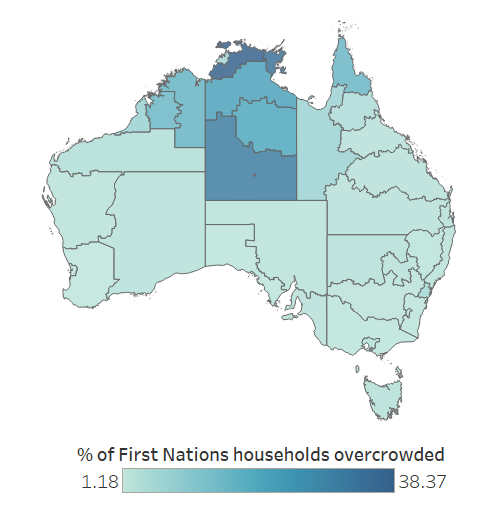Household overcrowding
Household overcrowding is a risk factor that is associated strongly with Group A streptococcus infection. An overcrowded dwelling is defined here using the Canadian National Occupancy Standard (CNOS) as one that requires at least one additional bedroom to accommodate the people who usually live there, given their ages, sex and relationships to each other (CMHC 2022). Although the concept of overcrowding can be a subjective one, influenced by cultural and personal factors, the CNOS-type standard generally underpins housing design across Australia.
In 2021, about 1 in 5 (19%) First Nations people lived in overcrowded households. Households in Very remote and Remote areas were more likely than those in non-remote areas to be overcrowded (31% and 16%, respectively, compared with 8%). Among those jurisdictions where ARF/RHD data are available, the proportion of First Nations people living in overcrowded households was highest in the NT (57%), followed by WA (21%), Qld (19%), SA (17%) and NSW (13%) (AIHW 2023a).
About 66% of all ARF and/or RHD cases are diagnosed or managed in regions that have high rates of household overcrowding (all Northern Territory regions, the Kimberley in Western Australia, and Torres Strait and Cape York in Queensland) (Figure 6.1).
Figure 6.1: Map of overcrowded First Nations households by Indigenous Region, 2021

Map: AIHW. Source: AIHW analysis of National Rheumatic Heart Disease Data Collection.
AIHW (2023a) Aboriginal and Torres Strait Islander Health Performance Framework measure 2.01 Housing-Table D2.01.9., AIHW, Australian Government, accessed 4 September 2023.
CMHC (Canada Mortgage and Housing Corporation) (2022) Canadian National Occupancy Standard, CMHC website, accessed 28 February 2024.


